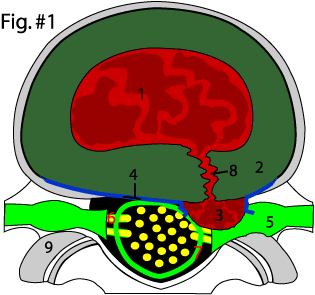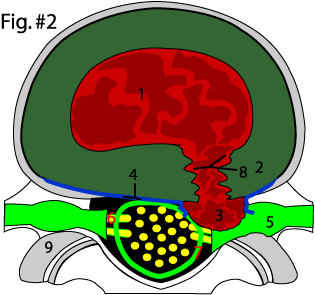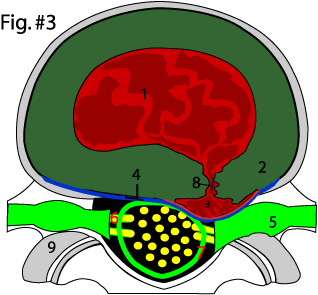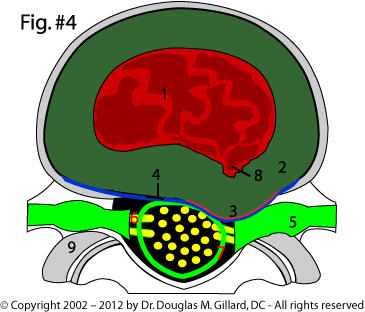|Bottom Line| The Study | Surgical Findings | Herniation/Anular Tear Types | Complete Results | Surgical Complications | Discussion
Carragee EJ, et al "Clinical outcomes after lumbar discectomy for sciatica: The effects of fragment types and annular competence" J Bone Joint Surg Am - 2003; 85(1):102-108
THIS STUDY IS AN ABSOLUTE 'MUST READ' FOR ANYONE COMTIMPLATING A LUMBAR DISCECTOMY!
This was an excellent paper written by the world famous, Volvo Award winning, ISSLS winning Professor Eugene Carragee MD, Orthopedic surgeon, Stanford University School of Medicine.
Bottom line? This study suggests that you are at the mercy of the size of the annular tear that produced your herniation. The patients who did the worst following discectomy were the ones that had an annular tear greater than 6 mm, or had no annular tear at all. The most successful group was surprisingly the small contained herniation that was associated with a narrow annular tear.
Carragee himself performed "limited posterior discectomies" on 187 sciatica patients that had failed conservative treatment and followed them for at least two years post surgery; the patients all were diagnosed as having disc lesions (herniations). At the time of surgery, the size and type of disc herniation was observed and noted. More importantly, the characteristics of the 'anuluar tear' that spawned the herniation was also fully described.
The goal of the study was to see if the type of annular tear was at all predictive of the long-term (two-year) outcome of the surgery and to note any complications. At two years, 96% of the patients were available for re-examination and questioning; this was an excellent turn-out. Another important feature of the study was the fact that patients involved in litigation were limited to 19% worker's compensation and 6% personal injury.
The outcome revealed that Carragee was indeed successful at demonstrating that surgical outcome was predicted by 'size of the annular tear' as well as the 'type of disc herniation' that was discovered during surgery.
In order to better understand the different types of annular defects that Dr. Carragee has classified, I've attempted to illustrate each from an over-head view. If you are not comfortable with disc anatomy, got here for a quick lession. You might also look at these pages, so you will understand the outcome measures of this study: 'Oswestry Disability Questionnaire' and the 'Stanford Score'.
Dr. Carragee started this paper with this quote: "Previous studies have demonstrated that 20% to 40% of patients who have had an open discectomy for the treatment of a herniated lumbar intervertebral disc have had persistent or recurrent sciatica, intractable back pain, or recurrent disc herniation's (1-9 tp (this paper))."
Why does surgery fail so often? Is there anything that can predict success?
"While some authors have claimed that the size of a disc herniation on MRI or CT has no predictive values with regard to sciatica (54, 55), others (56) have reported very high success rates for patients who have a large disc herniation that is excised by means of a posterior discectomy."
Some studies have shown that the size and shape of the protrusion will predict the outcome of surgery even more accurately that "clinical parameters" such as: 1) Worker's Compensation Status, 2) age, and 3) gender (57, 58). Still other studies have shown that "the integrity of the annulus fibrosus" [how badly is it torn] holds the key to predicting surgical success rates (59, 60, 61, 62). Let us not forget the other factors that I've previously reported on: 1) pre-surgical symptomatology duration, 2) amount of nerve root compression as seen on MRI, and 3) severity of the patient's symptoms.
As you can see, there still is great confusion, even amongst the worlds leading researchers, as to what constitutes the best means of predicting surgical outcome.
Dr. Carragee believes that the key to accurate outcome predictions (with regard to discectomy) are based on the type of disc herniation (either contained or extruded) and the size of the annular defect that was associated with that herniation.
One hundred and eighty seven disc herniation / sciatica patients were operated on by the author, Dr. Eugene Carragee. A Microdiscectomy via a small 'laminotomy' was performed on the bulk of the patients. In some patients all the work was done intralaminarly - so no cutting of the lamina was needed at all.
Inclusions: 1) Sciatica, in which the patients lower limb complaints were greater than their low back complaints, 2) Pre-operative MRI (not an Open MRI) demonstrating a disc herniation, and 3) 18 to 65 years of age.
Exclusions: 1) Previous back surgery, 2) Disc herniation located in the foramen or extraforaminally [outside of the neural canal], 3) stenosis, spondylolysis, spondylolisthesis, scoliosis, and other non-disc conditions that may irritate nerve roots, and (4) two-level disc herniation's.
Operative Findings: Each annular tear was visualized, explored, and rated as: 1) Large defect (>6mm) 2) Small Fissure (<6mm), or 3) Intact anulus. If a defect was found, it was explored to see if any 'free fragments' were present within it.
Carragee's Surgical Findings & Surgical Procedure:
| Extrusion: | An attached disc fragment (nuclear material) was found and removed, and the annular fissure explored, debrided (not deep) and measured. |
| Sequestration: | An unattached fragment of nuclear material was found & removed. The annular fissure was explored, debrided & measured. |
| Protrusion: | A covered 'bump' was found and 'picked open' with a probe, or incised open. The annular fissure was explored, debrided & measured. |
| Bulge: | A covered 'bump' was found, pick at and incised open with NO NUCLEAR FRAGMENT FOUND. The bulging anulus was then "piecemealed' back to vertebral boundary. (I assume they mean the anuluar material of the bulge was removed in mass.) |
The Four Disc Herniation/Annular Fissure Presentations:

Fragment Fissure-Herniation (Figure #1):
This herniation was characterized by an extruded (#3) or sequestered nuclear fragment/fragments that had broken through the PLL (uncontained) and entered the epidural space.
After removal of the fragment/fragments, which was not surrounded by any membrane, the annular defect (#8) was noted to be less than 6 (<6mm) millimeter in size, which classified it as being 'small'.
We will learn later that this group did very well with regard to surgical outcomes. It also had the lowest percentage of re-operations (1 out of 89 patients! or 1.1%), as well as, the lowest incidence of recurrent herniations.
Note that the posterior longitudinal ligament (blue line #4) as been ruptured or torn through in the nuclear material has entered the epidural space. This is what is meant by 'uncontained'.

Fragment Defect-Herniation (figure #2):
This herniation type was characterized by an extruded or sequestered fragment of nuclear material (#3) which was found in the epidural space.
It was typically associated with a "massive" annular defect (#8) that measured greater than 6 millimeters (>6mm).
Once again, the posterior longitudinal ligament (the blue line covering the back of the disc #4) was was completely ripped through. This group did absolutely terrible with regard to surgical outcomes. Specifically, 27% of them suffered a recurrent herniation during the study periord and 21% of those recurrent herniations necessitated another surgery because of their chronic pain.
By comparing Figure #1 with Figure #2 you can see the huge difference in the size of the annular tear that spawned the herniation. Its no wonder that this fragment disc-herniation group had a high pre-surgery Oswestry scores!
 Fragment Contained-Herniation (figure #3)
Fragment Contained-Herniation (figure #3)
This 'surprising' group was characterized by a contained protrusion (a.k.a., subligamentus herniation) that had NOT broken through the posterior longitudinal ligament and was found to be "covered with attenuated (dead) annular or areolar tissue".
In order to remove this contained protrusion, the membrane surrounding it had to be "broached" or 'picked at' with a surgical probe until this membrane covering 'popped' open (like popping a zit). Most of the time a detached nuclear fragment was encountered hiding behind the membrane." Once unearthed, these fragments were removed.
Surprisingly, this type of herniation (which I'm hoping is the type that I have (I did have) did very well with surgery, and in fact had the best subjective outcomes of all groups at the two year follow-up
The only disappointing results with this group of herniation was the fact that the re-surgery rate was a little higher compared to that of the Fragment-Fissure group. It was this little piece of research that has given me hope that surgery my help me.

No Fragment Contained-Herniation (Figure#4):
The final group was characterized by a contained protrusion (#3) that contained a membrane around the protrusion but did NOT contain a fragment/fragments of nuclear material when 'broached' by the surgeon.
This type of herniation was NOT a herniation at all, but a mere focal disc bulge, which could not be differentiated from a real disc protrusion on MRI.
The only surgical option for Carragee was to cut-out or "piecemeal-out" the bulging annulus. These patients did the worst of all groups.
Interestingly, in the patients who suffered a continuation of sciatica or a new sciatica after the surgery, new MRI results did NOT demonstrate a recurrent disc herniation in most cases, like they did in all other groups.
This group also had a higher percentage of litigated workers' compensation patients (31%), milder pre-operative symptoms, and a longer duration of pre-operative symptomatology, which may account for the poorer results.
Outcome Results & Surgically Discovered Disc Defects:
Surgical Classification of Herniation type: |
Fragment Fissure/HNP |
Fragment Defect / HNP |
Fragment Contained / HNP |
Non-Fragment Contained / HNP: |
Percentage in each group: 180 pats total: |
49% (89) |
18% (33) |
23% (42) |
9% (16) |
Pre-Op duration of symptoms: (weeks) |
16 (1-52) |
20 (2-104) |
15 (1-52) |
21 (3-52) |
Persistent/Recurrent Sciatica Rates:2 years |
1% (1) |
27% (9) |
12% (5) |
37% (6) |
Pre-Operation Oswestry score: |
48% |
51% |
45% |
39% |
Post-Op Oswestry scores - 2 years post: |
12% |
16% |
9% |
20% |
Over-All Oswestry Improvement Percent: |
75% |
69% |
80% |
49% |
Stanford Score: (0-10 10 is no pain): |
9.0 |
8.0 |
9.2 |
6.0 |
Confirmed Re-Herniation rate: 9% |
1.1%(1) |
27.3%(9) |
9.5(4) |
12.5(2) |
Rate of Re-Operation: 6.1% total: |
1.1%(1) |
21.2%(7) |
4.8%(2) |
6.3%(1) |
Workers' Compensation pats: |
18% (16) |
12% (4) |
21% (9) |
31% (5) |
As noted above in the 'results table', the most common herniation's discovered during surgery were of the Fragment Fissure type (49% of 89 patients), and the Fragment Contained type (23% of 42 patients). Fragment Defect herniation were found in 18% (of 32 patients) and No Fragment Contained herniation's were the rarest at 9% (of 16 patients).
The Fragment-contained and the Fragment-Fissure groups did the best with surgery as measured by the average Oswestry Disability and Stanford scores. The 80% improvement of the fragment-contained group was quite impressive. I could sure live with a 9% Oswestry or a 9.2 Stanford score! ( my score are currently 42 and 4.3 respectively.)
The Fragment-Defect group, which had the large gaping 6 millimeter + channel in their anulus (>6mm), did not do so well. That large channel or defect in the anulus, seemed to make the disc prone to 'recurrent herniation', as evident by the 27% re-herniation rate! A second surgery was given to 7 of the recurrent disc herniation group. 6 of the 7 second surgeries ( 2 arthrodesis's and 5 discectomy's ) were successful.
The Non-fragment group (aka: disc bulge group) also did not do well, although there seemed to be some 'monkey business' going on here. 31% of this group was on worker's compensation, which was much higher than in the other groups. Carragee also noted that, unlike the other groups, the non-fragment group's subjective complaints of Recurrent or persistent sciatica didn't match the objective post-surgical MRI findings as it did in the other three groups, i.e., 6 patients complained of recurrent sciatica, however, unlike all of the other recurrent sciatica patients in all other groups, only 2 of the non-fragment patients demonstrated an actual herniation on MRI!? Compare that to Frag-Defect group where 9 patients complained of recurrent sciatica and all 9 showed recurrent herniation on MRI. Us doctor's really like it when subjective MATCHES the objective!!! Unfortunately this often does not happen with workers compensation patients.
Since we are 'bashing' worker's compensation patients, I will add that Carragee noted the following: "patients with a Workers' Compensation claim had poorer outcomes than those who did not". (Stanford score, 8.0 versus 8.6 points; p=0.003).
Eighteen of the 187 surgically treated patients developed 'complications' as a result of the surgery. That's 9.6%. that's a little higher than I was expecting! Here a table of these complications:
Post Surgical Complications: |
Number of patients affected: |
Dural Tear: |
8 |
Transient footdrop: |
1 |
Prolonged wound drainage: |
1 |
Transient Ulnar nerve weakness: |
1 |
Partial suprascapular nerve palsy |
1 |
Superficial wound infection: |
1 |
Bilateral L5/S1 nerve palsy: |
1 |
Transient Cauda Equina Syndrome: |
1 |
Transient increased sciatica: |
1 |
Bladder retention requiring Catheter: |
2 |
Carragee notes that the 89 "Patients who had extruded disc herniation's with largely intact anuli (Fragment-Fissure herniation) did exceptionally well, with only one recurrence (1.1%) after five full years of observation! In contract, patients who had extruded fragments with large or massive anular defects (Fragment-Defect herniations) accounted for most of the clinically important reherniations and reoperations over time." The reoperation rate in the Fragment-Defect group was and "unacceptable" 21%, or 7 of 33 patients!
One surprising finding to me was that the group of contained herniation patients (Fragment-Contained) also did well! I was always under the assumption that 'us' contained herniation patients would NOT do well with surgery - but now maybe there's hope! This study probably is the one that will push me into trying the microdiscectomy. Carragee notes "patients with disc fragments contained within an intact anulus (Fragment-Contained herniations) tended to do well, with a 12% rate of recurrent sciatica; although this rate was higher than that in the Fragment-Fissure group." He did not mention that subjectively this group scored the best in all subjective areas; Best Oswestry result - 9% with an 80% improvement of their score, and best Stanford Score - 9.2 at 2 years.
Finally we come to the worse group, the non-fragment contained group. Carragee seems to insinuate that this group may have been tainted by the higher percentage of workers' compensation patients, whose subjective complaints of recurrent sciatica were 'unconfirmed' objectively by post MRI. Nevertheless, Carragee stated this: "The treatment of anular prolapses with no discrete fragments (No Fragment-Contained herniation group) by means of conventional anulotomy and limited discectomy was unsatisfactory. At one year after surgery, 38%, or six of sixteen patients, had notable recurrent sciatica. (Although) Most had NO objectively identifiable reherniations, and aggressive nonoperative methods (selective nerve blocks) did not lead to improved outcomes." (Maybe this was the workers' compensation / litigation factor?) Carragee goes on to note that the subjective outcome measures; Oswestry and Stanford Score reflected "dramatically poorer functional, pain, and satisfaction ratings compared with those for all other treatment groups." He continued to note that this group had milder preoperative symptoms, a longer preoperative course of failed conservative treatment, and a smaller herniation size on MRI. Finally he notes some of my concerns: "there were more compensation claims (worker's compensation), and psychometric abnormalities in this group. This small group of patients with sciatica appears to have a clinical profile resembling that of patients with chronic back pain who have attendant pain behavior and symptoms out of proportion with the pathoanatomical findings."
In closing it is noteworthy to note that Carragee warned that these results may NOT carry over for other surgical technique, i.e., precutaneous discectomy, or the standard discectomy.
This study is going to win the Volvo Award, or at least be in contention for that honor. The first thing that came to my mind was the question; 'Since we know that the surgical outcome is poor for patients with a large anular defect, (Fragment-Defect group), how can we tell in advance which patients would have such a defect without finding out during the surgery? DISCOGRAPHY! Ah, a word that Carragee hates, for he has been leading the crusade to disprove its effectiveness over the last eight years (50 - 53)! How ironic that his own magnificent study has possible revived the importance of a pre-surgical discogram for all potential discectomy patients. I'm curious why Carragee did not address the possible role in discography as a screening tool for patients considering discectomy. I will be discussing this with my surgeon on upcoming appointment.
References:
50) Carragee EJ, et al. (2002 ) " Provocative discography in volunteer subjects with mild persistent low back pain." Spine J. 2002 Jan-Feb ;2 (1):25-34
51) Carragee EJ, et al. (2001) " The rates of false-positive lumbar discography in select patients without low back symptoms" Spine. 2000 Jun 1 ;25 (11):1373-80; discussion 1381.
52) Carragee EJ (2000) " Is lumbar discography a determinate of discogenic low back pain: provocative discography reconsidered." Curr Rev Pain. 2000 ;4 (4):301-8.
53) Carragee EJ, et al. (2000) " Provocative discography in patients after limited lumbar discectomy: A controlled, randomized study of pain response in symptomatic and asymptomatic subjects." Spine. 2000 Dec 1 ;25 (23):3065-71.
54) Deyo RA, (1994) "Magnetic resonance imaging of the lumbar spine. Terrific test or tar baby? N Engl J Med - 1994; 331:115-116
55) Enzmann D, (1994) "On low back pain." AJNR Am J Neuroradiol." 1994; 15:109-13
56) Long DM, (1992) "Decision making in lumbar disc disease." Clin Neurosurg. 1992; 39:36-51
57) Carragee EJ, Kim DH, (1997) "A prospective analysis of magnetic resonance imaging findings in patients with sciatica and lumbar disk herniation." Spine - 1997; 22:1650-1660
58) Knop-Jergas BM, et al. (1996) "Anatomic position of a herniated nucleus pulposus predicts the outcome of lumbar discectomy." J Spinal Discord. 1996; 9:246-250
59) Elsmont FJ, Currier B, (1989) "Surgical management of lumbar intervertebral-disc disease." J Bone Joint Surg Am 1989;71:1266-1271
60) Burton AK , et al. (1995) "Psychosocial predictors of outcome in acute and subacute low back trouble." Spine - 1995; 20:722-728
61) Pople IK, Griffith HB (1994) "Prediction of an extruded fragment in lumbar disc patients from clinical presentations. Spine - 1994; 19:156-158
62) Vucetic N, et al. (1997) "Clinical history in lumbar disc herniation. A prospective study in 160 patients." Acta Orthop Scand. - 1997; 68:116-120